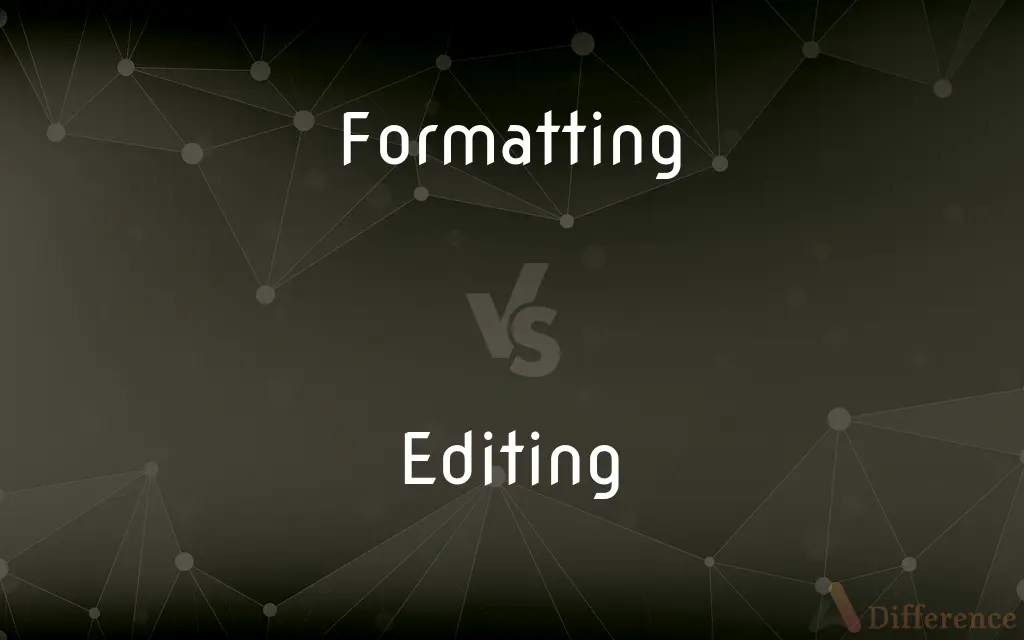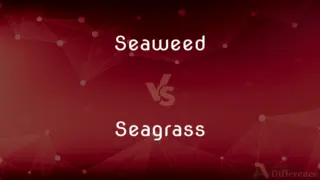Formatting vs. Editing — What's the Difference?
Edited by Tayyaba Rehman — By Maham Liaqat — Updated on March 11, 2024
Formatting involves the arrangement and style of text, while editing focuses on content quality, including grammar, clarity, and coherence.

Difference Between Formatting and Editing
Table of Contents
ADVERTISEMENT
Key Differences
Formatting refers to the process of arranging and designing text and documents to improve readability and aesthetic appeal. It includes adjusting font size, style, margins, spacing, and the organization of content into sections or headings. In contrast, editing is the process of reviewing and revising text to enhance its quality, clarity, and coherence. Editing involves correcting grammatical errors, refining language, ensuring consistency in tone and style, and improving the overall flow and structure of the content.
While formatting focuses on the visual presentation and structure of a document, making it more appealing and easier to navigate, editing concentrates on the content itself, aiming to communicate ideas more effectively. Formatting makes a document visually accessible and professional, whereas editing ensures the message is clear, concise, and free of errors.
The role of formatting is often technical, involving the application of design principles to make documents more reader-friendly and aligned with specific guidelines or standards. On the other hand, editing is inherently more subjective, requiring a deep understanding of language, context, and the author's intent to refine and polish the text.
Editors may work closely with authors to improve the narrative, adjust the tone, and clarify arguments, often involving significant rewrites or reorganization of content. Conversely, formatting can usually be applied more systematically, following predefined templates or styles, and often occurs after the main editing phases to prepare a document for publication or submission.
Both formatting and editing are crucial in the publishing process, contributing to the document's final quality. However, their focus and methods differ significantly: editing ensures the content's integrity and effectiveness, while formatting enhances its presentation and accessibility.
ADVERTISEMENT
Comparison Chart
Definition
Arranging text and documents for readability and visual appeal.
Reviewing and revising text for content quality and coherence.
Focus
Visual presentation and structure.
Content quality, including grammar, clarity, and coherence.
Process
Applying design principles, adjusting layout and style elements.
Correcting errors, refining language, improving flow.
Objective
To make documents visually appealing and easy to navigate.
To communicate ideas effectively and enhance narrative quality.
Tools
Software for layout design (e.g., Word, InDesign).
Language and style guides, editing software.
Compare with Definitions
Formatting
Adjusts document layout and structure for visual appeal.
He used formatting to ensure the report was visually engaging and easy to read.
Editing
Involves reviewing and revising text for clarity and coherence.
The editor focused on editing the manuscript to improve its overall clarity and flow.
Formatting
Organizes content into sections, headings, and lists for clarity.
Formatting the document included creating a clear hierarchy of headings for easier navigation.
Editing
Ensures consistency in tone, style, and voice.
She edited the articles to ensure a consistent tone throughout the publication.
Formatting
Applied after content editing to prepare for final submission or publication.
Once the editing was complete, the next step was formatting the manuscript for publishing.
Editing
May involve reorganizing content for better logical flow.
Part of the editing process involved restructuring sections for a more logical progression of ideas.
Formatting
Includes font style, size, margins, and spacing adjustments.
Proper formatting required adjusting the margins to meet the publication's guidelines.
Editing
Corrects grammatical errors and refines language use.
Editing included correcting spelling mistakes and awkward phrasing.
Formatting
Follows specific guidelines or templates for consistency.
She followed the journal's formatting guidelines to prepare her manuscript for submission.
Editing
Aims to enhance the narrative and communicate ideas effectively.
Through careful editing, the story's themes became more pronounced and impactful.
Formatting
A plan for the organization and arrangement of a specified production.
Editing
Editing is the process of selecting and preparing written, photographic, visual, audible, or cinematic material used by a person or an entity to convey a message or information. The editing process can involve correction, condensation, organisation, and many other modifications performed with an intention of producing a correct, consistent, accurate and complete piece of work.The editing process often begins with the author's idea for the work itself, continuing as a collaboration between the author and the editor as the work is created.
Formatting
The material form or layout of a publication.
Editing
To prepare (written material) for publication or presentation, as by correcting, revising, or adapting.
Formatting
The arrangement of data for storage or display.
Editing
To prepare an edition of for publication
Edit a collection of short stories.
Formatting
A method for achieving such an arrangement.
Editing
To modify or adapt so as to make suitable or acceptable
Edited her remarks for presentation to a younger audience.
Formatting
To plan or arrange in a specified form
They formatted the conference so that each speaker had less than 15 minutes to deliver a paper.
Editing
To supervise the publication of (a newspaper or magazine, for example).
Formatting
To divide (a disk) into marked sectors to allow for the storage of data.
Editing
To assemble the components of (a film or soundtrack, for example), as by cutting and splicing.
Formatting
To determine the arrangement of (data) for storage or display.
Editing
An act or instance of editing
Made several last-minute edits for reasons of space.
Formatting
The visual style of a document, including fonts, borders, etc.
Editing
Present participle of edit
Formatting
The code in a markup language which determines a document's format.
Editing
An act or instance of something being edited.
Formatting
Present participle of format
Editing
Putting something (as a literary work or a legislative bill) into acceptable form
Formatting
The organization of information according to preset specifications (usually for computer processing)
Common Curiosities
Do all documents require both formatting and editing?
Most professional or published documents benefit from both to meet quality and presentation standards.
Why is editing important?
Editing ensures the content is clear, coherent, and free of errors, enhancing its quality and effectiveness.
How do editors enhance the narrative of a text?
Editors refine language, ensure coherence, and clarify ideas to make the narrative stronger and more engaging.
Is editing the same as proofreading?
No, editing focuses on improving content quality, while proofreading is a final check for minor errors.
What comes first, editing or formatting?
Editing usually comes first to finalize the content before formatting for presentation.
Can formatting affect the readability of a document?
Yes, proper formatting significantly improves readability by organizing content and enhancing visual appeal.
How can formatting influence a document's reception?
Well-formatted documents are more engaging and easier to navigate, positively affecting the reader's perception.
What skills are essential for effective editing?
Critical thinking, language proficiency, and an understanding of the text's context and audience are crucial.
Are there different types of editing?
Yes, including developmental editing, copy editing, and line editing, each focusing on different aspects of the text.
Is it possible to over-edit a document?
Over-editing can occur, potentially stripping the text of its original voice or making it overly polished and less authentic.
Can formatting be standardized across documents?
Yes, many organizations use templates or guidelines to standardize formatting for consistency.
Can formatting styles vary between industries or fields?
Yes, formatting styles often vary significantly across different industries and academic fields.
What tools are used for formatting?
Tools include word processors and design software like Adobe InDesign.
How does editing contribute to a document's success?
By ensuring clarity, coherence, and polish, editing enhances the document's impact and readability.
Can poor formatting detract from a document's quality?
Poor formatting can make a document difficult to read and negatively impact the reader's engagement.
Share Your Discovery

Previous Comparison
Seaweed vs. Seagrass
Next Comparison
Crayfish vs. LobsterAuthor Spotlight
Written by
Maham LiaqatEdited by
Tayyaba RehmanTayyaba Rehman is a distinguished writer, currently serving as a primary contributor to askdifference.com. As a researcher in semantics and etymology, Tayyaba's passion for the complexity of languages and their distinctions has found a perfect home on the platform. Tayyaba delves into the intricacies of language, distinguishing between commonly confused words and phrases, thereby providing clarity for readers worldwide.
















































